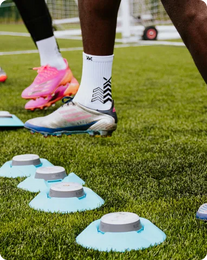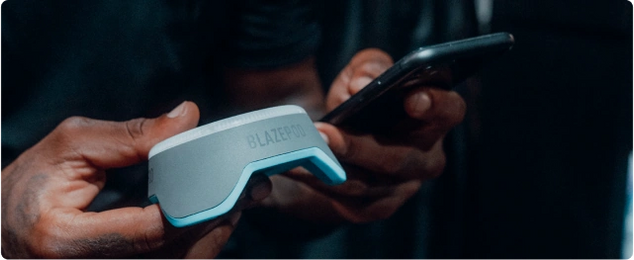The 4 3 3 soccer formation has been one of the most used strategies in the last 2-3 decades. This ball-hungry system is commonly associated with Dutch coaches and teams to an extent where they are thought to be its inventors. While they didn't actually invent it, the Dutch are the original creators of Total Football. This style of play heavily depends on the 4 3 3 formation and has dramatically changed the world's perception of how soccer should be played.

4 3 3 formation tactics have been widely used by most of the greatest clubs in soccer history. Louis Van Gaal heavily relied on it to build his successful tenure at Ajax in the '90s, and so did Pep Guardiola's all-conquering Barcelona squad in 2009. Fast forward in the modern game, PSG, Liverpool, and Man City's winning streaks using 4 3 3 formation tactics are excellent examples of how lethal this soccer strategy can be.
In this 4 3 3 formation guide, we give you a closeup look at soccer position numbers in 4 3 3, how to employ this strategy, and its key strengths and weaknesses.
How to Play 4 3 3 Formation
The 4 3 3 is more attack-oriented than other popular soccer strategies, including the 4-2-3-1 formation, 4-5-1, and the like. This system positions the players in 3 lines; a back four, three central midfielders, and three forward players.
Although this soccer formation has evolved a lot since its inception in the 1920s and 30s, its goal remains the same: occupy every inch of space in the midfield while making it a cinch to pass the ball to the front.
However, despite its proven success when playing counter-attacking, playing 4 3 3 requires specific players to make the most out of it. So, let's see each players' role when coaching the 433 system.
Get your BlazePod®
SHOP NOW4 3 3 Formation Numbers, Roles, and Type of Players
Goalkeeper
The keeper's primary role when playing the 433 soccer formation remains that of protecting the goal with his life. But since this strategy requires creating the play from the back, the goalie needs to have excellent ball skills to be able to support the first phase of the attack.
Having 4 players at the back plus a defensive midfielder essentially means that the goalkeeper is heavily protected from the flanks and front. However, since a simple mistake at the front can easily cause chaos at the back, the goalkeeper needs to be a person who can read the game through their vision of the pitch and pass commands effectively. In addition, excellent communication between the goalie and the defenders ensures that all gaps are covered as soon as they appear to minimize the danger.
In case of penetration, a goalkeeper with excellent footwork will pick out players and make precise passes when under pressure from opposing attackers. On the same note, you want a goalkeeper who can make long accurate shots to the front and advance up the pitch as the team pushes forward.
Another crucial role of goalkeepers in this soccer strategy is to sweep. Guardiola insists on keepers who can sprint forward to clear the ball from oncoming attackers. This way, they can disrupt a counter-attack even before it has started.
Central Defenders
The center backs are the backbone of the team when it comes to defending the goalie. So, they need to have the grit and do everything needed to prevent the opposing team from scoring.
The central defenders need to be excellent ballplayers with a strong physical presence and capable of breaking the first line of the offensive attackers. They should be good at moving forward with the ball under pressure and making perfect passes into the midfield. Good long ball precision will also come in handy in passing the ball to the strikers and wingers when the opposing defense is out of position.
Ideally, central defenders need to be agile and quick enough to get to the ball before the opposing strikers. If they arrive second, then they should possess excellent shielding ability to push the offensive attackers off the ball. The 2 players need to work closely and maintain adequate communication.
Fouls can be costly at this point. So you want central defenders with incredible aerial control and who can stay cool, especially under pressure. They should also be aggressive enough for tackles.
Fullbacks
Keeping up with the defensive role in soccer positions 4 3 3, the fullbacks have a critical job of supporting attack and defense throughout the match.
When playing defensively, the fullbacks stay goal-side, making it challenging for the opposition wingers to land crosses into the defensive third successfully. They also need to stay in sync with the defensive midfielder and central defenders to create the offside trap at the slightest opportunity.
When the team is in possession, the fullbacks have the onus of moving forward down the flank to support the attack. The right and left fullbacks should overlap with the winger to land crosses to the striker or make it easy for the winger to penetrate the box by creating 2vs1 situations.
Importantly, the two fullbacks should have a good understanding of each other's position on the other flank to adapt accordingly. For instance, if the left FB has sprinted forward to support the attack, the FB may need to shift inwards to support the defense.
During your 4 3 3 training sessions, you'll need extremely athletic and fit fullbacks to support attacks and defense throughout the match. On the same note, these positions require great game readers who can make quick decisions on whether to attack or hold their position.
Midfielders
Depending on the players at your disposal, the central midfielders may take any of the following 3 shapes; a flat three, a triangle with two attacking midfielders and one defending midfielder, and an inverted triangle with two defensive midfielders and one attacking midfielder.
If you're playing with a holding midfielder, then his role will be to remain behind when the other two push forward. The holding midfielder is tasked with detecting and filling any dangerous gaps left by their teammates. Additionally, these players should be ready to intercept and hold opposing strikers to win the ball back.
The other two midfielders collectively dictate the game from behind the forward and create goal-scoring chances for the team. One of them is assigned the role of controller and is responsible for setting the game's tempo. He's considered a box-to-box midfielder and is required to track back to tackle opposing attackers and block shots. But, equally, he should be adept at breaking into the attacking third and try to score.
The other midfielder is assigned the role of a creator. As the name suggests, this player is mainly involved in creating chances. In addition, he's responsible for linking the midfield with the forward.
Regardless of the 4 3 3 defensive shape that you employ for the midfield, these three players should possess precision passing skills as well as the ability to pick out players on the fly accurately. The ability to make long-range shots is often an added advantage.
Forwards
This is where we see the team's 4 3 3 soccer formation tactics and effort culminate into success. In line with this system's attacking orientation, the forwards are mainly responsible for putting pressure on the opposition's defense anticipating that they will make a mistake.
Like in the midfield and depending on the type of players available, you may arrange the forwards in a flat line, with a false 9 or two number 10s behind a central striker.
When playing a flat forward configuration, the wingers should be quick and excellent dribblers. These two are supposed to take on opposition defenders and provide precise crosses into the box. Often the fastest in the team, the wingers maintain excellent communication with the striker and fullbacks. They should be quick decision-makers to determine whether to slide inside and allow more space to the oncoming fullbacks or maintain their position to allow for overlap.
As for the central striker, your ideal player will depend on the tactics you want to employ. FC Barcelona coach Ronald Koeman often prefers having Antoine Griezmann- a physically strong target play who can easily latch on to long balls from midfielders and crosses from the wingers. As the team's primary scorer, the striker needs to have an eye for the goal. The striker also needs to be a formidable player able to hold the ball until teammates join the attack.
Get your BlazePod®
SHOP NOW4 3 3 Soccer Formation Advantages and Disadvantages
Strengths
One of the major advantages you get when playing a 4 3 3 soccer formation is the strength in the middle. With 3 capable midfielders protecting the 4-man defense, you'll dominate the pitch from the midfield forcing the opposing attackers outwards.
The other strength of this system is the multiple passing angles and lines that it creates. Coupled with the correct 4 3 3 soccer drills, your players will always have lots of passing options at their disposal, and this helps a lot in linking the entire team. Besides allowing for quick passes, these links also help in exerting dominance and countering high pressure.
Also, with the possibility of having up to 7 players bombing forward, it's easy to overwhelm and pressure your opponents into dangerous mistakes. But what's even more interesting is that disciplined players can easily transition from attack mode into their defensive positions as the game dictates.
Another reason why 4 3 3 never goes out of fashion is its tactical flexibility. With all-rounded players, this formation can easily morph into different connotations, including 451, 4231, and 4141, depending on who you're facing.
Do you have several quality players that you'd like to make the team? No problem! The structure of this soccer formation, coupled with its demand for elite players, makes it possible to bring all your quality wingers, midfielders, and strikers into the game at once.
With the presence of a true number 9, your fullbacks are always well covered when sprinting forward as the holding midfielder can slide across to fill any gaps that the opponent may think of exploiting.
The other advantage of playing 4 3 3 in soccer is that it's a player-friendly formation. No player wants to feel left out in soccer. They want a formation that allows them to be dynamic and attack-minded both when the team is in and out of possession. The 4 3 3 formation is just that, and it motivates your players to get out there and show what they can do.
Get your BlazePod®
SHOP NOWWeaknesses
The 4 3 3 soccer formation requires particular players owing to its narrow configuration. If any of the players aren't playing their role as needed, it's easy to lose control of the game.
While this system is meant to occupy every inch of space in the center, a lot of space is left behind the back 4 when the team streams forward. This leaves your team vulnerable to counterattacks, specifically from the flanks.
Also, the 4 3 3 formation heavily relies on the midfielders. If they don't have the stamina and work rate to support the team, then the attacking force is lost, and it becomes a challenge to get the ball to the final third.
Lastly, there's the risk of the fullbacks getting too excited when attacking, thereby forgetting to trackback to fulfill their defensive duties.
Energy, discipline, speed, and fitness are vital attributes if you want to get the most out of any soccer formation. Add Blazepod to your 4 3 3 training drills and leverage its predefined activities and boost your players' agility, stamina, and explosiveness. This reflex light training system also allows you to upload customized activities to fit your players' age, strength, and abilities.






















